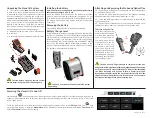
23
EN
- Next, the signal at the filter output is shown:
The power gain of a single channel amplifier is
calculated as follows:
GAIN = POWERoutput - POWERinput
The amplifier’s gain using this example would be:
100.4 - 44.1 = 56.3 dB.
- Make the necessary adjustments in the filter until
the output is optimum.
4
.- Analysis of the frequency response of the
filters and amplifiers, thus allowing their
adjustment.
In this case it is usually advisable to use the -30
dB output of the noise generator, in order to
avoid saturation in the single channel amplifier.
Remember that if the -30 dB is used, you must use
a 75 ohm load in the main output.
- Connect the noise generator to the amplifier
input (in this case it is a single channel amplifier).
The signal at the generator output is as follows:
- Connect the field meter to the amplifier output.
- Check that the noise in the input does not
saturate the amplifier.
Summary of Contents for 593001
Page 40: ...40 ...
Page 41: ...41 ...
Page 42: ...42 ...
Page 43: ...43 ...
Page 44: ...593001_000_ ES EN IT DE ...
















































